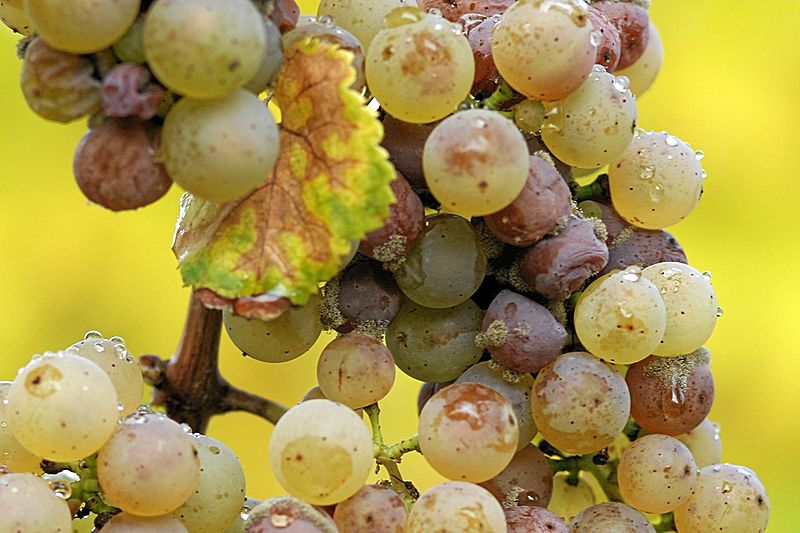 Would you eat grapes like the ones pictured above? No? I probably wouldn't either. But in the right hands, they can make wonderful wine. They have been infected with a fungus called Botrytis canerea that causes the grape berries to shrivel, and winemakers have recognized for centuries that such botrytized grapes are to be prized rather than thrown out. In fact, Botrytis canerea is commonly known as the noble rot because the shriveling that it induces concentrates the sugars, juices, and flavors of the infected grapes and imparts an unctuous, sweet, honey-like flavor to the resulting wine.
Would you eat grapes like the ones pictured above? No? I probably wouldn't either. But in the right hands, they can make wonderful wine. They have been infected with a fungus called Botrytis canerea that causes the grape berries to shrivel, and winemakers have recognized for centuries that such botrytized grapes are to be prized rather than thrown out. In fact, Botrytis canerea is commonly known as the noble rot because the shriveling that it induces concentrates the sugars, juices, and flavors of the infected grapes and imparts an unctuous, sweet, honey-like flavor to the resulting wine.The king of botrytized wines is Sauternes, named after a commune in the Graves region of Bordeaux. Sauternes is a mixture of Sauvignon Blanc, Semillon, and Muscadelle grapes, although the Semillon typically predominates because it is the most susceptible to Botrytis canerea. Unusually for a wine region, there is one undisputed master of Sauternes production: Château d'Yquem. Ask 100 wine experts what the best Sauternes producer is, and I would wager dollars to doughnuts that all 100 will respond Yquem. Yquem's prices certainly bear that out: a 375 ml bottle of the 2003, the most recent vintage now on the market, will retail for close to $200, far more than any other Sauternes. I've always wanted to try Yquem; but as profligate as I am, I'm loath to spend $200 on half a bottle of wine. So I have not. On an excursion to the store yesterday morning to pick up a shallot, however, I made an impulse purchase of another, much lesser, Sauternes: a 375 ml bottle of 2003 Château Haut-Mayne. I know nothing whatever about this estate (or even whether it is really an estate), and I have been unable to find anything online with a quick Google search. I can tell you, however, that I enjoyed their wine very much. It was, well, vinous honey: sweet, syrupy, delicious. Many dessert wines (at least the ones that aren't fortified) will be lower in alcohol than typical table wines. They have to be because their sweetness comes from unfermented sugar, and the sugar levels of the grape juice that is vinified aren't really much higher than those for regular wine. Not so Sauternes. The Botrytis concentrates the grape juice to such an extent that there is plenty of sugar to ferment to a high degree of alcohol while leaving more than enough to keep the wine super-sweet. The Haut-Mayne was 14.5% alcohol and still as sweet as you could ask for. I enjoyed it very much. It certainly made me want to try other, more well-reputed Sauternes -- maybe not Yquem, but certainly something more reasonable like Château Guiraud or Château Rieussec.
Oh, and unless you're hosting a big dinner party, get the 375 ml bottles. The stuff is simply too rich to consume much of it. It would surprise me if four people could finish a 375 ml bottle and wish that there were more.


No comments:
Post a Comment